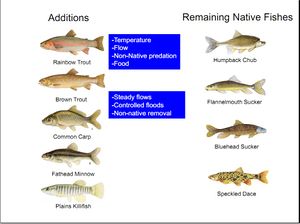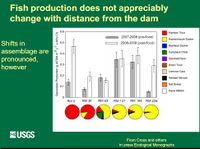Difference between revisions of "FISH"
Cellsworth (Talk | contribs) |
Cellsworth (Talk | contribs) |
||
| Line 116: | Line 116: | ||
2015 | 2015 | ||
| + | *[https://drive.google.com/file/d/0BwY-Z2c3NTUGUUpWR0U2OWc3YmM/view/ Mercury and Selenium levels in the Grand Canyon foodweb] | ||
*[http://www.usbr.gov/uc/rm/amp/twg/mtgs/15jan20/Attach_10.pdf/ Native and Nonnative Interactions; Factors Influencing Predation and Competition] | *[http://www.usbr.gov/uc/rm/amp/twg/mtgs/15jan20/Attach_10.pdf/ Native and Nonnative Interactions; Factors Influencing Predation and Competition] | ||
*[http://www.usbr.gov/uc/rm/amp/twg/mtgs/15jan20/Attach_17.pdf/ Quagga Mussel Risk Assessment] | *[http://www.usbr.gov/uc/rm/amp/twg/mtgs/15jan20/Attach_17.pdf/ Quagga Mussel Risk Assessment] | ||
Revision as of 13:41, 7 January 2016
|
Description The Colorado River running through Grand Canyon once hosted one of the most distinctive fish assemblages in North America. The wild Colorado River presented fish with a challenging and variable aquatic habitat: very large spring floods, near-freezing winter temperatures, warm summer temperatures, and a heavy silt load. Note that only eight fish species were native to Grand Canyon. Of the eight species, six are endemic, meaning that they are only found in the Colorado River basin. (NPS)
|
| Fish Species of the Colorado River in Lower Glen Canyon and Grand Canyon (See Fish Table) |
TBD (TBD) |
TBD (TBD) |
|---|
|
|

